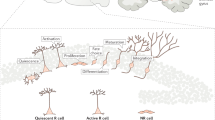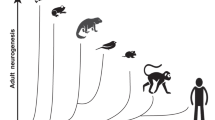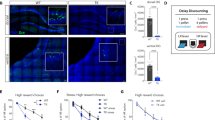Abstract
The genesis of new cells, including neurons, in the adult human brain has not yet been demonstrated. This study was undertaken to investigate whether neurogenesis occurs in the adult human brain, in regions previously identified as neurogenic in adult rodents and monkeys. Human brain tissue was obtained postmortem from patients who had been treated with the thymidine analog, bromodeoxyuridine (BrdU), that labels DNA during the S phase. Using immunofluorescent labeling for BrdU and for one of the neuronal markers, NeuN, calbindin or neuron specific enolase (NSE), we demonstrate that new neurons, as defined by these markers, are generated from dividing progenitor cells in the dentate gyrus of adult humans. Our results further indicate that the human hippocampus retains its ability to generate neurons throughout life.
This is a preview of subscription content, access via your institution
Access options
Subscribe to this journal
Receive 12 print issues and online access
$259.00 per year
only $21.58 per issue
Buy this article
- Purchase on SpringerLink
- Instant access to full article PDF
Prices may be subject to local taxes which are calculated during checkout





Similar content being viewed by others
References
Altman, J. &. Das, G.D. Autoradiographic and histological evidence of postnatal hippocampal neurogenesis in rats. >J. Comp. Neurol. 124, 319–335 ( 1965).
Altman, J. & Das, G.D. Postnatal neurogenesis in the guinea-pig. Nature 214, 1098–1101 (1967).
Caviness, V.S. Time of neuron origin in the hippocampus and dentate gyrus of normal and reeler mutant mice: an autoradiographic analysis. J. Comp. Neurol. 151, 113–120 (1973).
Gueneau, G., Privat, A., Drouet, J. & Court, L. Subgranular zone of the dentate gyrus of young rabbits as a secondary matrix. A high-resolution autoradiographic study. Dev. Neurosci. 5, 345–358 (1982).
Kuhn, H.G., Dickinson-Anson, H. & Gage, F.H. Neurogenesis in the dentate gyrus of the adult rat: Age-related decrease of neuronal progenitor proliferation. J. Neurosci. 16, 2027–2033 ( 1996).
Gould, E., Tanapat, P., McEwen, B.S., Flugge, G. & Fuchs, E. Proliferation of granule cell precursors in the dentate gyrus of adult monkeys is diminished by stress. Proc. Natl. Acad. Sci. USA 95, 3168– 3171 (1998).
Kaplan, M.S. & Bell, D.H. Mitotic neuroblasts in the 9-day-old and 11-month-old rodent hippocampus. J. Neurosci. 4 , 1429–1441 (1984).
Kaplan, M.S. & Hinds, J.W. Neurogenesis in the adult rat: electron microscopic analysis of light radioautographs. Science 197, 1092–1094 (1977).
Stanfield, B.B. & Trice, J.E. Evidence that granule cells generated in the dentate gyrus of adult rats extend axonal projections. Exp. Brain Res. 72, 399– 406 (1988).
Cameron, H.A., Woolley, C.S., McEwen, B.S. & Gould, E. Differentiation of newly born neurons and glia in the dentate gyrus of the adult rat. Neuroscience 56, 337– 344 (1993).
Dolbeare, F. Bromodeoxyuridine: a diagnostic tool in biology and medicine, Part I: Historical perspectives, histochemical methods and cell kinetics. Histochem. J. 27, 339–369 ( 1995).
Kempermann, G., Kuhn, H.G. & Gage, F.H. Genetic influence on neurogenesis in the dentate gyrus of adult mice. Proc. Natl. Acad. Sci. USA 94, 10409–10414 (1997).
del Rio, J.A. & Soriano, E. Immunocytochemical detection of 5'-bromodeoxyuridine incorporation in the central nervous system of the mouse. Dev. Brain Res. 49, 311– 317 (1989).
Gundersen, H.J. et al. The new stereological tools: disector, fractionator, nucleator and point sampled intercepts and their use in pathological research and diagnosis. APMIS 96, 857–881 (1988).
West, M.J. Regionally specific loss of neurons in the aging human hippocampus. Neurobiol. Aging 14, 287–293 (1993).
Coggeshall, R.E. & Lekan, H.A. Methods for determining numbers of cells and synapses: a case for more uniform standards of review. J. Comp. Neurol. 364, 6– 15 (1996).
Kempermann, G., Kuhn, H.G. & Gage, F.H. More hippocampal neurons in adult mice living in an enriched environmen Nature 386, 493– 495 (1997).
Mullen, R.J., Buck, C.R. & Smith, A.M. NeuN, a neuronal specific nuclear protein in vertebrates. Development 116, 201–211 (1992).
Wolf, H.K. et al. NeuN: A useful neuronal marker for diagnostic histopathology. J. Histochem. Cytochem. 44, 1167– 1171 (1996).
Sloviter, R.S. Calcium-binding protein (calbindin-D28k) and parvalbumin immunocytochemistry: localization in the rat hippocampus with specific reference to the selective vulnerability of hippocampal neurons to seizure activity. J. Comp. Neurol. 280, 183–196 ( 1989).
Schmechel, D., Marango, P.J., Zis, A.P., Brightman, M. & Goodwin, F.K. Brain enolases as specific markers of neuronal and glial cells. Science 199, 313– 315 (1978).
Kirschenbaum, B. et al. In vitro neuronal production and differentiation by precursor cells derived from the adult human forebrain. Cereb. Cortex 4, 576–589 ( 1994).
Rakic, P. Limits of neurogenesis in primates. Science 227, 1054–1056 (1985).
Eckenhoff M.F. & Rakic, P. Nature and fate of proliferative cells in the hippocampal dentate gyrus during the life span of the rhesus monkey. J. Neurosci. 8, 2729 –2747 (1988).
Kempermann, G., Kuhn, H.G. & Gage, F.H. Experience-induced neurogenesis in the senescent dentate gyrus. J. Neurosci. 18, 3206– 3212 (1998).
Gage, F.H. et al. Survival and differentiation of adult neuronal progenitor cells transplanted to the adult brain. Proc. Natl. Acad. Sci. USA 92, 11879–11883 ( 1995).
Suhonen, J.O., Peterson, D.A., Ray, J. & Gage, F.H. Differentiation of adult hippocampus-derived progenitors into olfactory neurons in vivo. Nature 383, 624–627 ( 1996).
Acknowledgements
We thank G. Kempermann, T. Palmer, E. Brandon, M.-C. Senut, K. Sakurada, L. Chehabeddine and M. L. Gage for their comments, and H. van Praag for the contribution of rat tissue. In addition, we thank L. Kitabayashi for technical assistance. This study was supported by grants from the Swedish Medical Research Council (project no. K98-12X-12535-01A), Faculty of Medicine, University of Göteborg, the Gunvor and Josef Anérs Stiftelse, the John and Brit Wennerströms Stiftelse for Neurologisk Forskning, the Rune and Ulla Amlövs Stiftelse for Neurologisk and Reumatologisk Forskning, NHR-fonden, Stiftelsen Göteborgs MS förenings forsknings och byggnadsfond, Stiftelsen Handlanden Hjalmar Svenssons Forskningsfond, Göteborgs Läkaresällskap, Hjärnfonden, The Swedish Society of Medicine, Stiftelsen Lars Hiertas Minne, Stiftelsen Assar Gabrielssons Fond and the Edit Jacobssons Fond and from NIA and NINDS and the Alzheimer's Association (F.H.G.) and the American Federation for Aging Research (D.A.P.).
Author information
Authors and Affiliations
Rights and permissions
About this article
Cite this article
Eriksson, P., Perfilieva, E., Björk-Eriksson, T. et al. Neurogenesis in the adult human hippocampus. Nat Med 4, 1313–1317 (1998). https://doi.org/10.1038/3305
Received:
Accepted:
Issue date:
DOI: https://doi.org/10.1038/3305
This article is cited by
-
Glial-restricted precursors stimulate endogenous cytogenesis and effectively recover emotional deficits in a model of cytogenesis ablation
Molecular Psychiatry (2024)
-
Adeno-associated Virus-mediated Ezh2 Knockdown Reduced the Increment of Newborn Neurons Induced by Forebrain Ischemia in Gerbil Dentate Gyrus
Molecular Neurobiology (2024)
-
Mental stress recognition on the fly using neuroplasticity spiking neural networks
Scientific Reports (2023)
-
In conversation with Rusty Gage
Nature Neuroscience (2023)
-
Amyloid β-based therapy for Alzheimer’s disease: challenges, successes and future
Signal Transduction and Targeted Therapy (2023)



